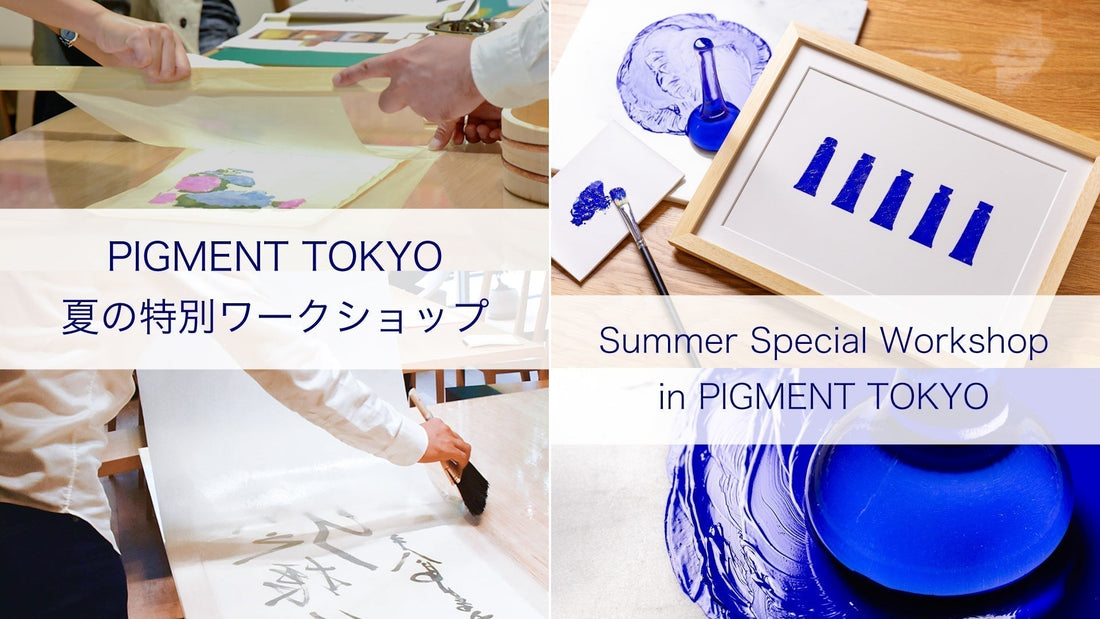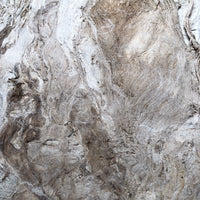PIGMENT TOKYO often provides special workshops that are only available during the summer.
For the summer of 2023, we hosted two courses for those who are interested in art, materials, preservation of artworks and conservation techniques.
Even though the idea of mounting art with traditional methods and making paints with traditional recipes are both deeply related to the art-making process, many artists may have not done it by themselves.
Therefore, these special workshops are a great opportunity to learn the techniques that have been passed down through centuries and are still used today.
*This event has ended.
Find the latest information about our workshops here
WORKSHOPS - PIGMENT TOKYO
The first workshop is about traditional art mounting techniques that support art pieces.

[Special Workshop] Urauchi Backing
Date: August 12, 2023 (Saturday)
Time: 13:00-17:00
Instructor: Yasunori Monobe (from Monobe Gasendo)
Fee: ¥16,500 (including tax and materials)
Age Recommendations: Suitable for all ages
Reservation: [Special Workshop] Urauchi Backing 23/08/12
[Things to Bring]
We recommend our participants bring several works on paper or silk up to F10 size (53cm x 45.5cm) for backing practice. Any work, regardless of whether it is your own or another artist's is fine. If you are not sure if your work can be applied with Urauch backing, feel free to contact us by email.
It is possible to just join the workshop and learn the techniques without bringing any art pieces, PIGMENT TOKYO will prepare some art samples for those who don’t have paintings with them.
Urauchi backing is a technique used to strengthen and prevent the damage of artworks using paper or silk as a support material. It is also an important preparation process when making a Japanese hanging scroll, frame, sliding door or folding screen.
Today, many people apply Urauchi backing on art pieces for display or long-term storage, instead of making them into Hyogu*.
However, because of the need for specific tools and techniques, it is a very difficult process for a beginner to learn on their own.
Therefore, this workshop is designed for those who want to learn Japanese art mounting and who want to apply this mounting technique to their own art practices by learning Urauchi backing through the basic techniques of preservation and conservation
*Hyogu is a mounting process of making traditional Japanese artworks such as hanging scrolls, scroll paintings, frames, sliding doors, folding screens, or partitions out of paper, silk, or decorated fabric.
Here is an overview of the workshop.
Tools and procedures will be explained in an easy-to-understand manner for beginners. And feel free to ask the instructor if you have any questions during the workshop.
After the demonstration, it is time to start applying the Urauchi backing.

《Washi paper》How to wet Washi paper with a Hake brush.
It is difficult to avoid wrinkles, coils and looseness on art pieces if the paper has not been mounted or when silk has been removed from a wooden frame.
Paper and silk are highly flexible substrates and can be easily affected by humidity.
They stretch in high-humidity conditions and shrink in dry and low-humidity, causing wrinkles and stretches due to the difference in elasticity between the substrates and the paints.
However, Urauchi backing takes it as an advantage and makes the surface smooth by wetting the art pieces with a special Hake brush or mist sprayer.
During this preparation process, paper and silk have different specifications. Different substrates have different properties and the procedures and tools are tailored to each unique characteristic. Knowing the characteristics of the materials and their handling may give you a new perspective on future production, presentation and storage considerations for your artwork.

Apply glue with a Hake brush to the back side of the artwork that has stretched out, then apply a piece of thin Washi paper to reinforce the work.
There are specialized Hake brushes for each process in Urauchi backing and the point is the material of the bristles.
Each tool and technique is inherited by traditional artisans and they all have a reason why to use them. You will be able to learn art materials and traditional techniques by watching the craftsman's skill in person.

《Silk》Urauchi backing
This large brush is called “Uchi-bake” and is an essential tool for backing fabrics such as silk and textiles.
The heavy weight and thickness of the brush are for crimping silk and Urauchi paper.
Moreover, it makes the artwork more flexible as it is pressed and it is less likely to break when rolled up for storage.

Stretching the artwork temporarily on a board
After Karibari, it is time to finish the backing.
"Karibari" is the process of temporarily stretching your artwork on a board and allowing the art piece to dry flat.
The board for Karibari is made by building wood in a lattice pattern and gluing Kozo paper on the front and back, then applying several layers of Kakishibu (persimmon tannin) to the surface.
Karibari board is one of the tools that cannot be bought in stores and it takes time to make. Although it can be made with alternative materials, one of the best parts of this workshop is the opportunity to use authentic tools like this.
Once the dried art piece is peeled off from the Karibari board, it is done!
These articles introduce more details about Urauchi backing.
Another workshop which is in high demand is the oil paint-making workshop.

[Special Workshop for Summer]
Creating Original Oil Paints
Dates: August 5 (Sat), August 19 (Sat), August 26 (Sat), 2023
Time: 14:00-16:30
Instructor: Kei Saito (PIGMENT TOKYO art materials expert)
Fee: ¥9,900 (including tax and materials)
Age Recommendations: Junior high school students and above
Reservations:
August 5 (Sat) [Summer Holiday Special Introduction] Creating Original Oil Paints 23/08/05 -
August 19 (Sat) [Summer Holiday Special Introduction] Creating Original Oil Paints 23/08/19
August 26 (Sat) [Summer Holiday Special Introduction] Creating Original Oil Paints 23/08/26
When you hear the word "oil paint," what’s the first thing that comes to mind?
The ingredients are very simple. It is made by mixing pigments with oil.
In the first half of the workshop, you will make your own oil paints with the classical method and learn about the characteristics of the material based on its history. In the second half, you will experience the beauty of oil paint by creating artwork with your handmade paints.
There is already a draft on the canvas and the remaining part is covered with masking tape so that anyone can concentrate on painting, including beginners and those who are not confident in drawing.
On the other hand, those who are already familiar with oil paints may find this a good opportunity to expand their range of expression by creating paints from raw materials.
Next, let’s take a look at how paints and artworks are made.

As I mentioned before, oil paint is made by mixing pigment with oil as a binder.
In this workshop, an oil color medium is used as the binder and it is made of plant-derived stearic acid and safflower oil, a dry oil pressed from safflower seeds.

As for the colorant, Suihi pigment is used in this workshop.
The name "Suihi" comes from refining with water “Sui (Japanese word for water)” and then drying “Hi (Japanese word for to dry)” them out. Because the particles of Suihi pigments are very fine, they can be mixed with other Suihi pigments.
The paints can be made by combining your favorite colors from the selection of 20 colors.
The time when the pigments mix with the medium and gradually turn into wet colors is one of the most interesting parts of the whole paint-making experience.

The method of kneading paint using a marble plate and a muller used in this workshop is the origin of the modern paint-making process.
The instructor will give a demonstration of the materials, tools and procedures.

Even if the same pigment is used, a rainbow of colors can be created depending on the way you combine the pigments. You may mix and match intuitively and be surprised by the unexpected or try to create your favorite color by following the color wheel and your instinct.
After kneading the paints well, you will have rich colors with the depth and luster that only oil paints can offer.
Next, apply the freshly made oil paint to a cotton canvas.

Apply a thick coat of paint to the white canvas with a stiff hog bristle brush.
After applying the paint, you can remove the masking from the canvas carefully to reveal the silhouette of a paint tube.
You can observe the texture, heaviness and vividness of oil paint, and if you usually use other color materials such as watercolor paints, you will be surprised by the difference in penetration into the substrate and transparency.
If you would like to take home the leftover oil paints after the workshop, please ask the instructor to wrap them in plastic wrap film. (Please note that we do not provide any paint tubes.)

We will provide a cushioning material so that you can safely take your finished artwork home in a wooden frame.
You may display your work at your home and enjoy observing the slow change as the paint dries.
Moreover, we also provide workshops that you can experience with your children and family.
For example, the following workshop is recommended for parents and children who want to learn art materials and techniques while using this opportunity for their summer homework.
【PIGMENT ARTICLES】PIGMENT TOKYO Summer Vacation –Kids and Family Workshops–
Therefore, we look forward to seeing you joining us in one of these art workshops that would bring inspiration to your creative practice, work or even a good time in this summer holiday!
Translated by Atsumi Okano and Nelson Hor Ee Herng
PIGMENT TOKYO Art Materials Experts


